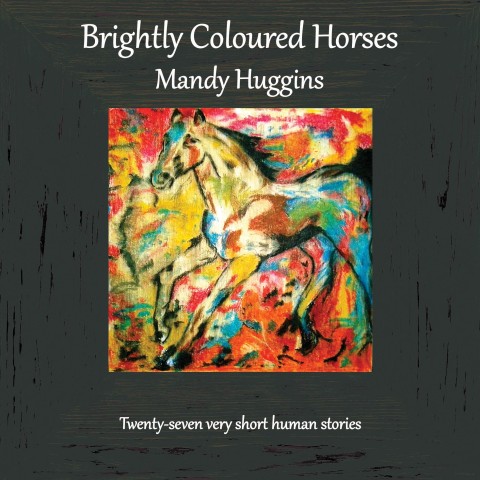
by C.A. Schaefer
The title of Mandy Huggins’ collection, Brightly Coloured Horses (Chapeltown Books, 2018), evokes images of a childhood toy box. The stories inside this treasure chest are beautifully jumbled into an assortment that echo, overlap, and subvert each other. The epigraph, a quotation from Willa Cather that argues that “there are only two or three human stories,” serves not only as philosophical guide to the collection, but as a reminder that familiarity between stories is not a trap to avoid, but a strategy to be embraced.
Every story invites us to peer into the lives of its characters, returning to familiar narratives of loss and betrayal, or else healing and reparation. The collection circles the question of what it means to be with another person. Characters converge and then separate, or join together in astonishing love. In the title story, the narrator feels a profound and terrible isolation from her lover, realizing that even in the middle of a Parisian idyll, only she will recall these images and sensations as vividly as she does; her lover will return to his marriage, dismissing this experience and allowing it to fade. “She had felt sure that this moment would save them, but it was too busy, too impersonal.” Some relationships refuse redemption; in “Shooting Stars,” a wife imagines adultery a thousand times before she commits it. This wife, like so many of Huggins’ narrators, has moments of keenly devastating insight. “No one can protect her from what she wanted,” she says in a moment of realization. In “Fatal Flaw,” the narrator echoes her, declaring life as “the possibility of damage from which there can be no recovery.”
It is frequently Huggins’ vivid and precise descriptions of objects that speak to the connections between her characters. Some objects offer an elusive hope of redemption: a pair of yellow shoes serve as a harbinger of hope for a desperate young woman in “Twenty Dollar Shoes;” a jar of bean paste that sustains a memory of a lost beloved from “The Last of Michiko;” in “Kisses,” a biscuit dipped in tea acts as a substitute for a kiss. Other objects portend disaster. A small red ball, carelessly tossed out a window, catalyzes a horrifying accident in “Blood Red.” In “Car by Car,” a shining “curvaceous coupe” is witness to the end of a relationship and the fragments of the self that are inevitably lost during a separation.
But Brightly Coloured Horses sometimes warns us against believing too much in the redemptive power of these objects. In “The Turquoise Silk,” a child enamored with her mother’s “glittering tangle of diamante bracelets, necklaces of tiny iridescent shells, and cocktail rings set with rubies, amethysts, topaz, and amber” is devastated to realize that her mother values order and beauty over her child’s chaotic desires. “The Right Castanets” offers a story steeped in yearning, a child who tries to erase her father’s adulterous transgressions by searching for a perfect gift that he can offer her. But these objects fail to redeem and transfigure. In the end, they remain simply things, as they do in “Perfect Word,” which muses on the failure of these transformations. “The body of Christ can’t save me,” the mourning narrator muses, “only the blood of Christ: the wine that I drink to lessen the unexpected weight of grief.” In “Only the Best,” a wryly tragic variation on “Gift of the Magi,” an impractical object illuminates how profound the disconnection between a husband and wife can be.
Huggins turns away from the inanimate and towards the animal world throughout her collection. The sweetness and horror of animal behavior highlights some of the absurdities of human relationships. In “Nelson,” a small and beloved cat is discovered swirling limply in a washing machine. Although it miraculously survives, the cat and the narrator’s lover flee the next day, leaving the narrator bereft and waiting. The united actions of a pair of dung beetles, staggering together towards a blade of grass in “The Dung Beetle Race” is far more faithful than a human’s promise to return. Throughout the collection, dead rabbits, swooping seagulls, tiny crabs, and beautifully free dogs offer glimpses of a life deeper and richer than the tragicomedy of broken human relationships.
Huggins’ work is perhaps most piercing and revelatory in her moments of ambivalence. In “Whatever Speed She Dared,” a woman contemplates free and wild driving but hesitates because of a shadowy memory of bodies buried in peat. The narration only offers this incomplete reason, and refuses any further questions. Huggins allows us glimpses of understanding in these stories: the memory of a body, a trapped goose, or a moment of grace offered by the rain.
In a few of the pieces, however, these revelations don’t resonate as deeply as others do. Sometimes the pieces incorporate more thorough exposition, and their mysteries are resolved too quickly and completely. Sometimes, too, the language slips away from beautiful strangeness, and instead offers the occasional cliché. These are rare occasions in the collection, though; most of the stories linger beautifully, and their familiar chords begin to overlap in my memory, so that I am not always able to separate one story from another. These stories speak to each other, celebrating nuance, contradiction, and confusion. There may be, as Brightly Coloured Horses reminds us, only two or three stories, but their variations are both imaginative and tender.
__________________________________
 C.A. Schaefer’s stories and creative nonfiction have appeared in Indiana Review, Mid-American Review, Phantom Drift, Passages North, and other journals. A former editor of Quarterly West, she holds a Ph.D. from the University of Utah. She currently teaches writing and other humanities courses in Salt Lake City.
C.A. Schaefer’s stories and creative nonfiction have appeared in Indiana Review, Mid-American Review, Phantom Drift, Passages North, and other journals. A former editor of Quarterly West, she holds a Ph.D. from the University of Utah. She currently teaches writing and other humanities courses in Salt Lake City.

